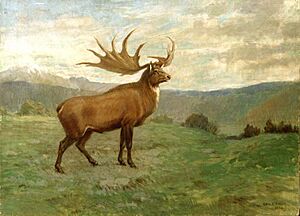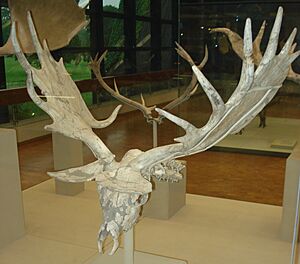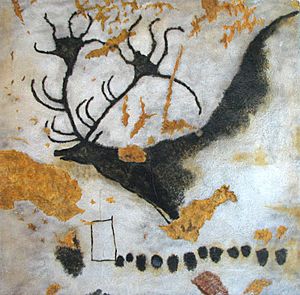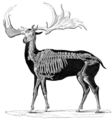Irish elk facts for kids
Quick facts for kids Irish elk |
|
|---|---|
 |
|
| Mounted skeleton in Bremen | |
| Scientific classification | |
| Kingdom: | |
| Class: | |
| Order: | |
| Family: | |
| Genus: |
†Megaloceros
|
| Binomial name | |
| †Megaloceros giganteus (Blumenbach, 1799)
|
|

The Irish elk (Megaloceros giganteus) was a truly giant deer! It was one of the biggest deer that ever lived. These amazing animals roamed across a huge area called Eurasia. This stretched from Ireland all the way to China.
Scientists believe the last Irish elk lived about 7,700 years ago. We know this because of a special test called carbon dating. Many of their skeletons have been found in Irish bogs (wetlands). Even though it's called the 'Irish elk', it wasn't closely related to today's elk or moose. That's why some people prefer to call it the Giant Deer.
Contents
What Did the Irish Elk Look Like?
The Megaloceros giganteus first appeared about 400,000 years ago. It was a very tall animal. It stood about 2.1 metres (6.9 ft) (7 feet) high at its shoulders.
The most amazing thing about the Irish elk was its huge antlers. They were the biggest antlers of any known deer species. From tip to tip, they could measure up to 3.65 m (12.0 ft) (12 feet) across! These massive antlers could weigh as much as 40 kg (88 lb) (88 pounds).
In terms of body size, the Irish elk was similar to the largest living moose. It weighed about 450–600 kg (990–1,320 lb) (990-1,320 pounds). Some very large ones weighed 700 kg (1,540 lb) (1,540 pounds) or more. You can see many Irish elk skeletons at the Natural History Museum in Dublin.
Why Were Their Antlers So Big?
The huge size of the Irish elk's antlers has always fascinated scientists. One main idea is that the antlers grew so big because of sexual selection. This means that males with bigger, more impressive antlers were more likely to attract females. They also used their antlers to show off to other males.
Some people used to think the antlers got so big they caused the elk to go extinct. They thought the antlers became too heavy or hard to manage. But this idea is not true! Animals don't survive for hundreds of thousands of years if they can't live normally. The antlers were actually perfect for showing strength and impressing others. The Irish elk didn't even have to turn its head to show off its antlers. It could just look straight ahead!
How Did the Irish Elk Go Extinct?
Scientists have two main ideas about why the Irish elk and other large ice age animals died out. One idea is that big climate changes were the main reason. The other idea is that hunting by early humans played a big part. It's likely that both reasons contributed to their extinction.
Growing such huge antlers needed a lot of special minerals. The male elk got these minerals partly from their own bones. After the antlers grew, they would get the minerals back from the plants they ate. This meant that while their antlers were growing, the elk were a bit like people with osteoporosis.
When the climate warmed up after the last ice age, the plants in the elk's habitat changed. However, the very last Irish elk found in Siberia, which lived 8,000 years ago, seemed healthy. It didn't show signs of not getting enough nutrients. This area had a different climate where the plant changes hadn't happened yet.
It seems that as the climate changed, the Irish elk populations became separated. They faced a tough choice: live in good habitats where humans hunted them, or live in less ideal places where there were fewer humans. This combination of factors likely led to their disappearance.
Images for kids
See also
 In Spanish: Alce irlandés para niños
In Spanish: Alce irlandés para niños







